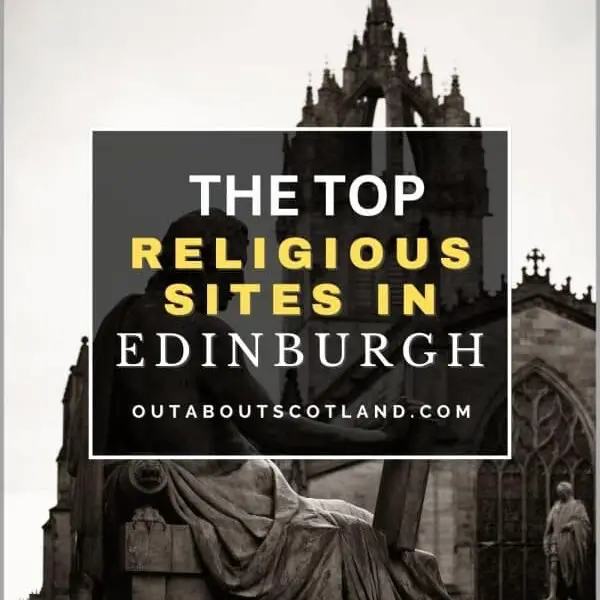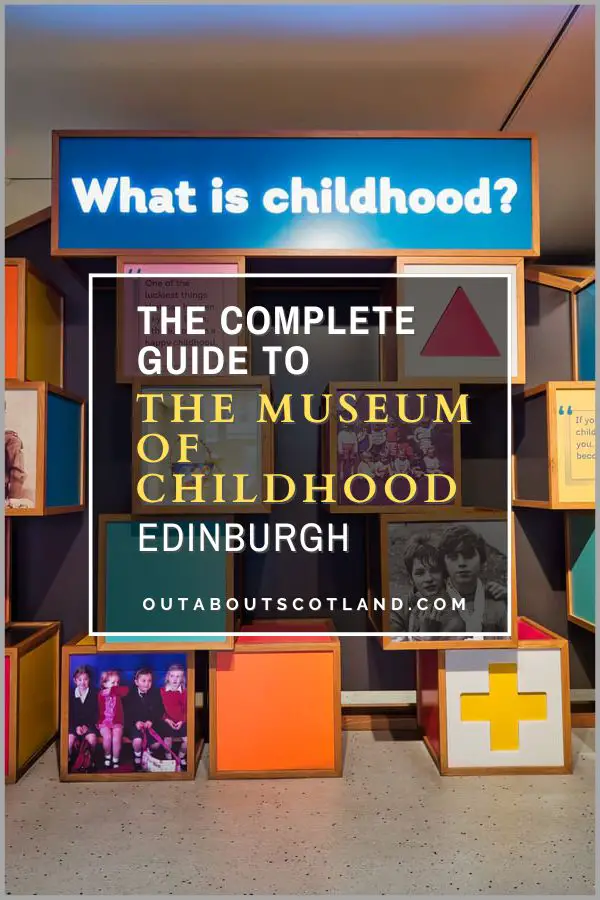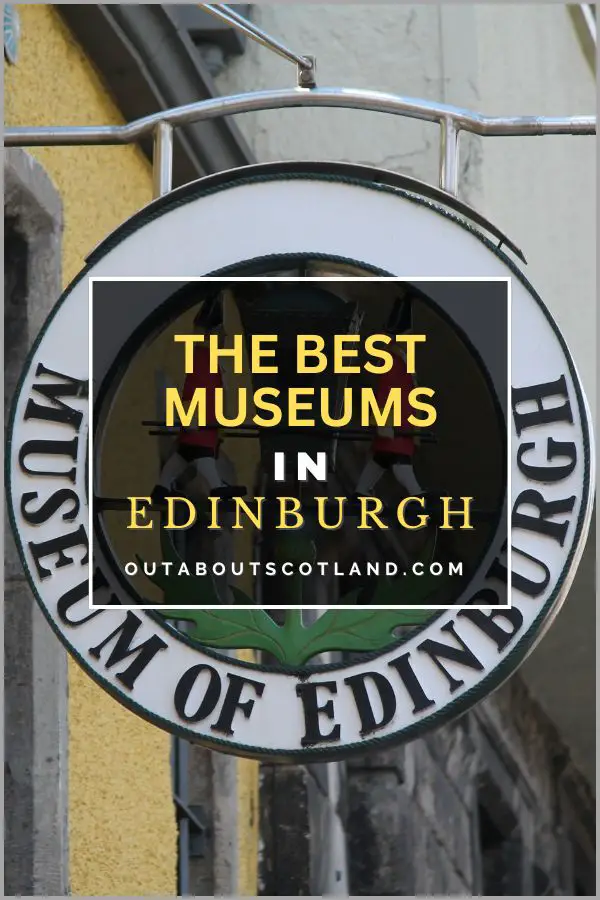Edinburgh, the enchanting capital of Scotland, is a city steeped in history, culture, and breathtaking architecture. Although most tourists tend to make a beeline for the castle, there are many beautiful churches and cathedrals that are also worth including in a sightseeing tour of the city, from St. Giles’ Cathedral (known as the ‘High Kirk’) to the 17th-century Greyfriars Kirk, which is now famous for its ties to Harry Potter.
In this article, we’ll venture into the city’s top religious sites, all of which offer a captivating glimpse into the city’s past. Whether you’re a history buff or just looking for things to do in Edinburgh, you’re guaranteed to fall in love with the city’s awe-inspiring religious buildings.
St. Giles Cathedral
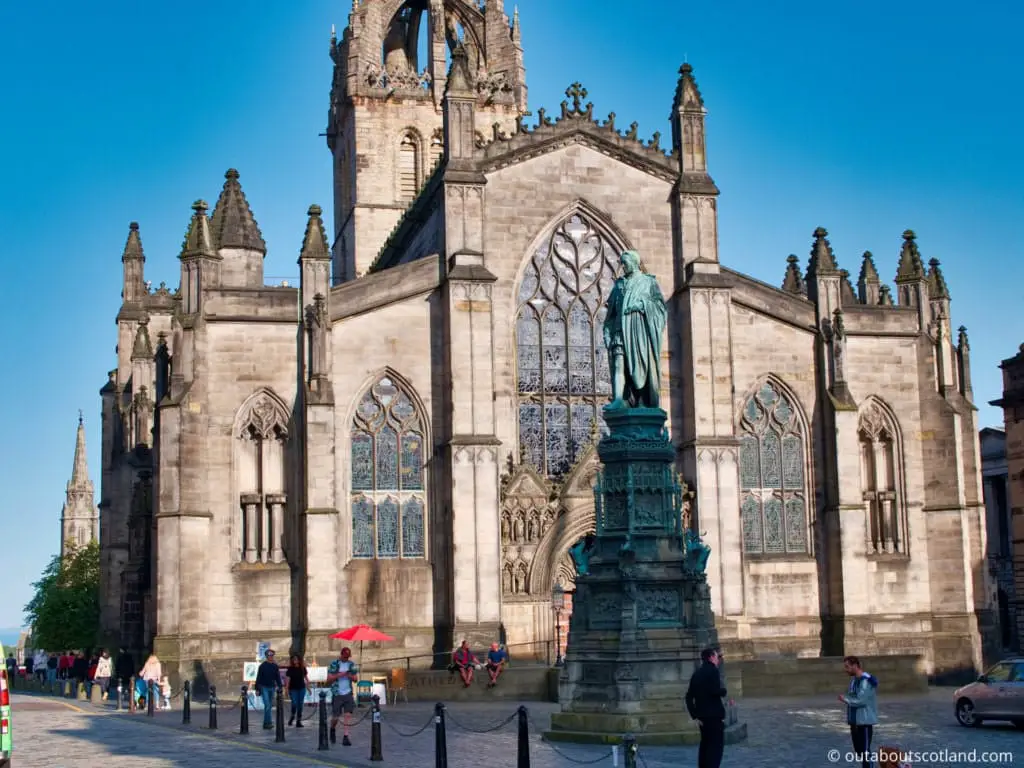
| Address: | High Street, Edinburgh, EH1 1RE |
| Opening Hours: | Monday – Friday 10:00am – 6:00pm Saturday 9:00am- 5:00pm Sunday 1:00pm-5.00pm |
| Admission Price: | Free |
| Parking: | None |
| Contact: | 0131 226 0677 |
| Facilities: | Shop, guided tours, audio tour |
| Photos: | Virtual Tour YouTube Video |
Out About Scotland Guide: St. Giles Cathedral
St. Giles Cathedral, also known as The High Kirk, is one of the top religious sites in Edinburgh and is a prominent historical and architectural landmark in the heart of the city on the famous Royal Mile. King David I founded the cathedral in the 12th century, and since then, it has played a significant role in Scotland’s religious and political life.
The architecture of St. Giles Cathedral is primarily Gothic but it has had several additions made to the exterior over the centuries including the iconic crown steeple which was added in the 15th century and is now one of the most prominent features of Edinburgh’s skyline.
St. Giles Cathedral has been at the centre of many pivotal moments in Scotland’s history, but perhaps the most important was the Reformation of the 16th century, when John Knox, founder of the Presbyterian Church of Scotland, preached his influential sermons. Knox was instrumental in guiding Scotland to become the country we know today, so if you’d like to learn more about him, I recommend taking a visit to John Knox House which is located a short walk down the Royal Mile.
In addition to being a place of worship, St. Giles Cathedral has hosted several royal ceremonies over the years including the coronation of King Charles I in 1633, and more recently the thanksgiving memorial for Queen Elizabeth II in 2022, so it’s fair to say that a visit is an absolute must for any Edinburgh tourist.
The interior of the nave, which features intricate carvings, sizable stone pillars, and stunning stained glass windows, is both grand and beautiful. There are several notable monuments and memorials that are worth paying extra attention to, including the Thistle Chapel, which is dedicated to the Order of the Thistle (Scotland’s highest order of chivalry), and the Victorian windows, which are among the finest stained glass windows in Britain.
St. Mary’s Episcopal Cathedral
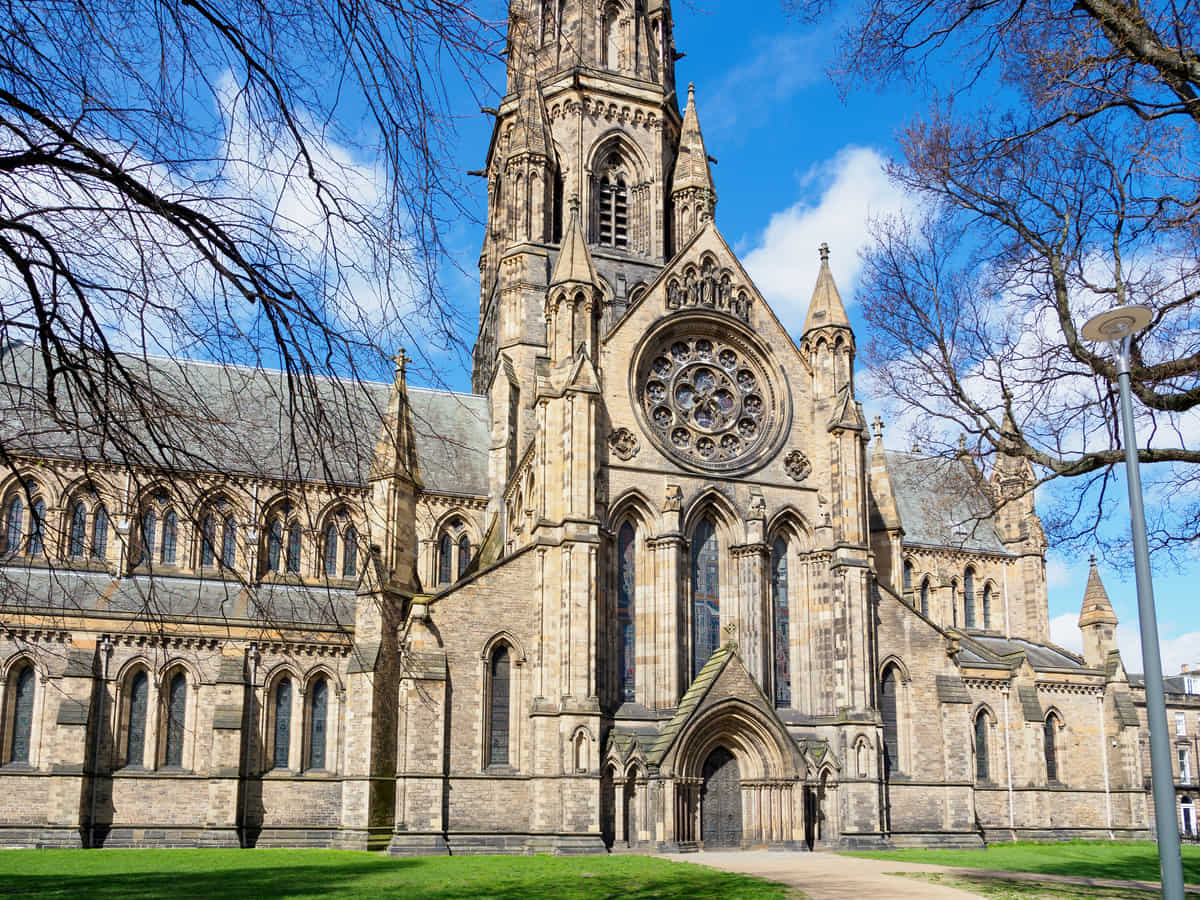
| Address: | Palmerston Place, Edinburgh, EH12 5AW |
| Opening Hours: | Open from 8am to 6pm every weekday and 8am to 5pm on Saturday and Sunday |
| Admission Price: | Free entry |
| Parking: | No on-site car park |
| Contact: | Tel: 01312256293 email: office@cathedral.net |
| Facilities: | Toilets |
| Photos: | Virtual Tour YouTube Video |
Out About Scotland Guide: St. Mary’s Cathedral
The history of St. Mary’s Episcopal Cathedral dates back to the 19th century, when it was constructed as the main seat of the Scottish Episcopal Church. The Duke of Buccleuch laid the foundation stone in 1874, and the cathedral received its official consecration in 1879.
Designed by the renowned architect Sir George Gilbert Scott, the cathedral is an outstanding example of Gothic Revival architecture. It boasts a unique combination of intricate stone carvings, beautiful stained glass windows, and soaring spires that dominate the skyline in Edinburgh’s often-overlooked West End.
Over the years, the cathedral has been given several new additions, but two of the most notable are the Rood Cross, which is part of the National War Memorial that was designed in 1922, and the unmistakeable Paolozzi Millenniumm Window (installed in 2000), which showers the interior of the cathedral with a dazzling display of multicoloured lights.
The cathedral is the biggest place of worship in the city, and as you enter, you can’t help but feel overwhelmed by the interior’s sheer size and the high altar’s exquisite carvings at the far end of the nave. If you visit Edinburgh with a camera, St. Mary’s Cathedral should be high on your list of places to photograph.
In addition to being a popular historic attraction, St. Mary’s is renowned for its choir, which is part of Scotland’s only full-time independent specialist music school. The choir regularly performs at services and concerts throughout the UK, and you’ll often hear them singing throughout the year, especially during the Fringe Festival when special events are held throughout the month of August.
Greyfriars Kirk
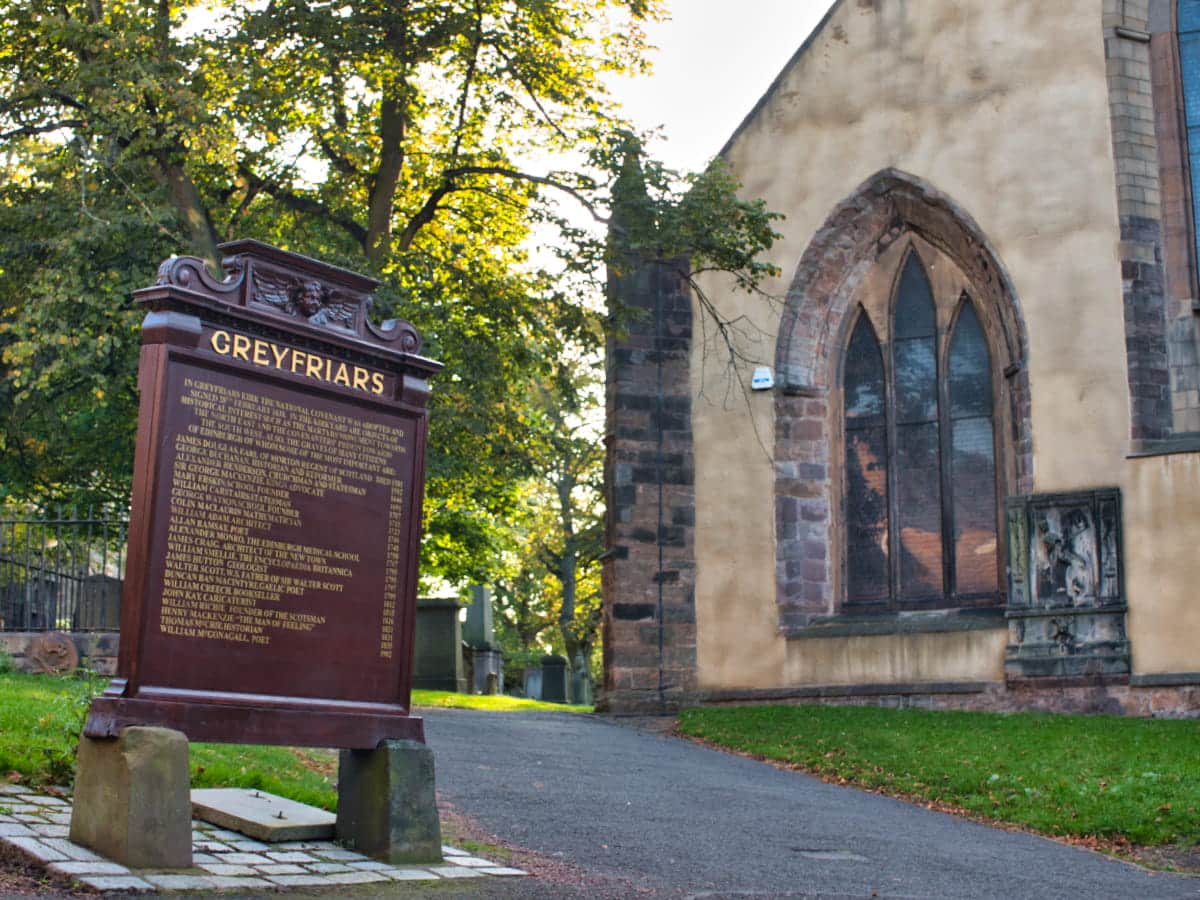
| Address: | 1 Greyfriars, Edinburgh, EH1 2QQ |
| Opening Hours: | Opening hours of the kirk vary throughout the year. Visit https://greyfriarskirk.com/ for details. The kirkyard is open 24 hours. |
| Admission Price: | Free entry |
| Parking: | No on-site parking. Paid car parking spaces in Chambers Street. |
| Contact: | 0131 2251900 contact@greyfriarskirk.com |
| Facilities: | Disabled access and toilets, shop, museum, guided tours |
| Photos: | Virtual Tour YouTube Video |
Out About Scotland Guide: Greyfriars Kirk
Located in the heart of the Old Town, Greyfriars Kirk is one of the most historically important churches in Edinburgh, drawing more than a million people annually which makes it the city’s second most popular free attraction after the National Museum of Scotland.
Established in the early 1600s, the church was built to accommodate Edinburgh’s rapidly expanding population which had outgrown St. Giles Cathedral by the late 1500s, so construction of this new site of worship began in 1611 with the first service being held on Christmas Day in 1620.
The Kirk is named after the ‘Grey Friars’ who first came to Scotland in 1447 and founded a Franciscan friary on the site where the current building is located.
Though not as important as St. Giles, Greyfriars Kirk has seen just as many pivotal events throughout its history, including the signing of the National Covenant in 1638 and the 1650–1653 occupation of Edinburgh by Oliver Cromwell, used the church as a barracks.
Many notable Scots have been associated with Greyfriars Kirk throughout its history including George Buchanan, a renowned Scottish historian, statesman William Carstares, and philanthropist Thomas Guthrie, while recent years have seen previously unknown names elevated to superstar status courtesy of author J.K. Rowling who saw inspiration in the gravestones of Potter, Riddell, McGonagall, and Black.
The church’s stunning Gothic architecture and beautiful stained glass windows make for a captivating experience for tourists but the highlight has to be the adjacent Greyfriars Kirkyard which is the final resting place of many prominent Scots such as poet Allan Ramsay and architect James Craig who designed Edinburgh’s New Town.
In addition, Greyfriars Kirk is home to the heartwarming local legend, Greyfriars Bobby. The loyal Skye Terrier is said to have guarded his master’s grave for 14 years after his death, and a statue commemorating the faithful dog can be found near the church’s entrance, while his gravestone can be found at the main entrance of the kirkyard.
Parish Church of St. Cuthbert
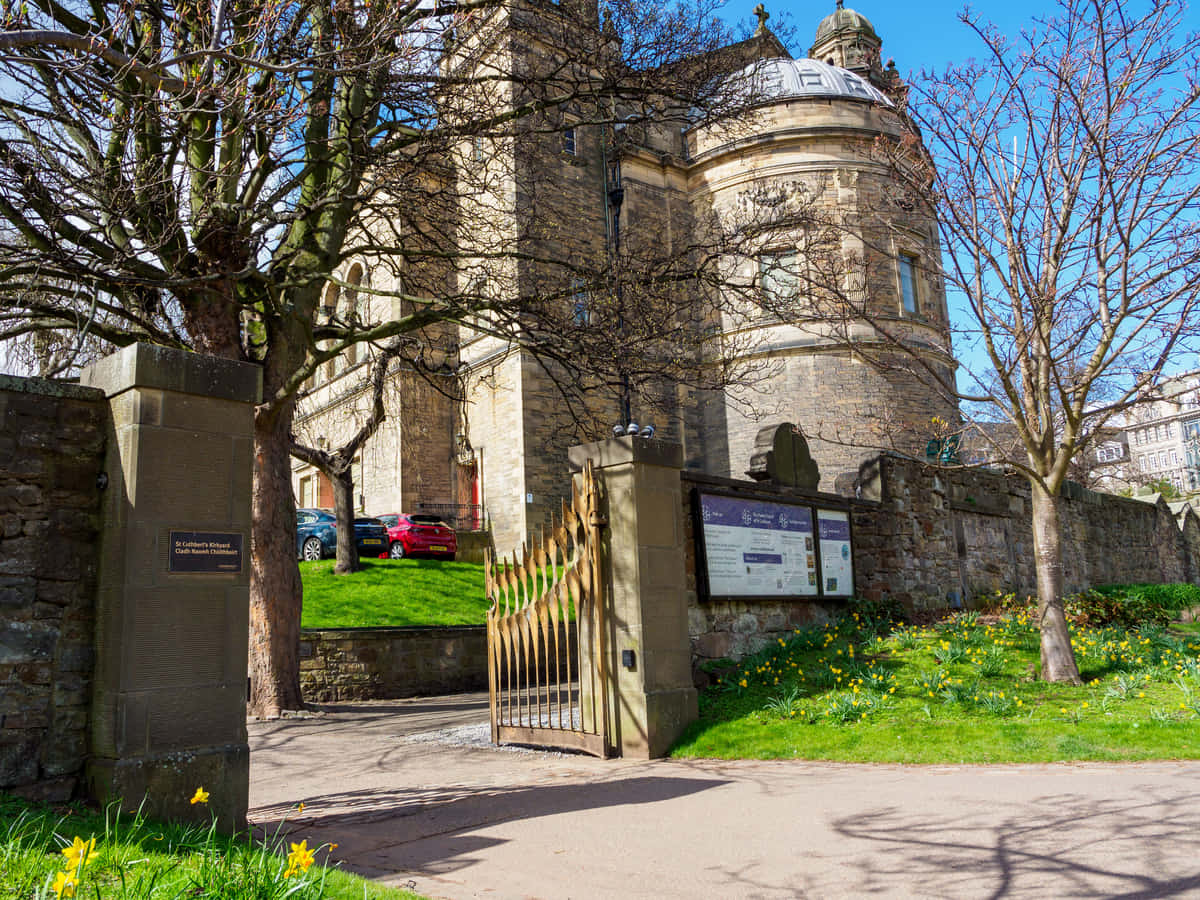
| Address: | 5 Lothian Road, Edinburgh, EH1 2EP |
| Opening Hours: | April to September: Tuesday-Friday 10.00am – 3.00pm |
| Admission Price: | Free entry |
| Parking: | No on-site car park |
| Contact: | email: office@stcuthberts-edinburgh.uk Tel: 0131 229 1142 |
| Facilities: | Toilets, gift shop |
| Photos: | Virtual Tour YouTube Video |
Out About Scotland Guide: St. Cuthbert’s Church
The Parish Church of St. Cuthbert, nestled at the foot of Edinburgh Castle on the western end of Princes Street Gardens, is a prominent religious site with a rich history dating back to the 7th century. The current church building, an outstanding example of Georgian architecture, was completed in 1894, but the site has been home to a place of worship since the early Middle Ages, with the first recorded church dating back as far as 1128.
There is a legend that in the 7th century, St. Cuthbert preached where the church now stands—hence the name of the current building—though there are thought to have been at least seven earlier churches built on the site.
A visit is highly recommended as the church’s stunning interior features beautiful stained glass windows that depict scenes from the Old Testament as well as intricate stone carvings that depict the last supper and a magnificent pulpit made from rare stone imported from Italy.
Adjacent to the church is the historic St. Cuthbert’s Churchyard, a peaceful oasis in the heart of the bustling city which has several noteworthy burials including the mathematician and astronomer John Napier, the artist Sir Henry Raeburn, and the architect George Meikle Kemp who designed the nearby Scott Monument.
A visit to St. Cuthbert’s will take around an hour to fully explore both the church and the graveyard (both of which are free to enter), but if you’d like a quick look beforehand, check out my virtual tour, which you’ll find here.
St. Margaret’s Chapel
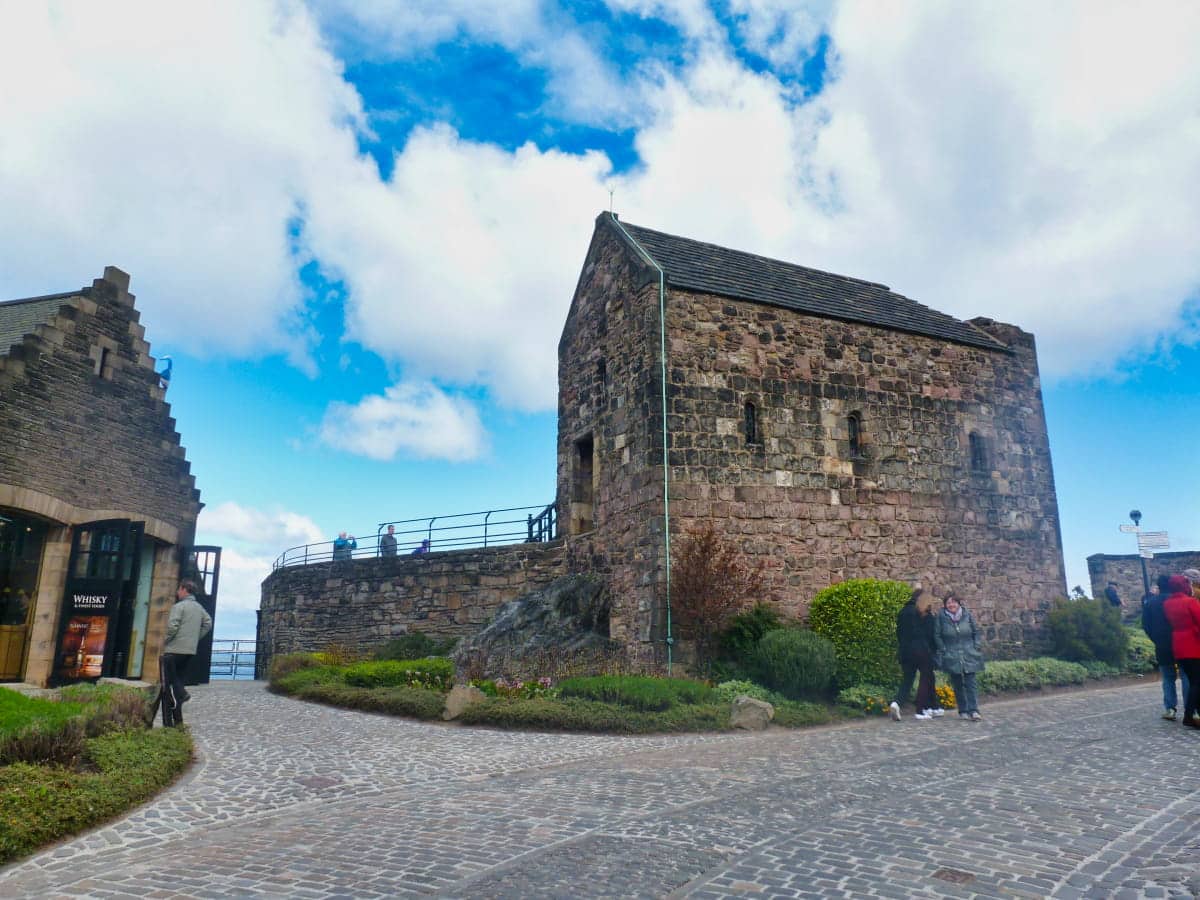
| Address: | The Esplanade, Edinburgh, EH1 2NG |
| Opening Hours: | 1 April to 30 September: 9.30 am to 6 pm (last entry 5 pm) 1 October to 31 March: 9.30 am to 5 pm (last entry 4 pm) |
| Admission Price: | Adult (16-64yrs): £21.00 Concession (65yrs+ and unemployed): £17.00 Child (5-15yrs): £12.50 Family (1 adult, 2 children): £41.50 Family (2 adults, 2 children): £60.50 Family (2 adults, 3 children): £72.00 |
| Parking: | No on-site car park. Paid car parks across Edinburgh. |
| Contact: | +44 (0)131 225 9846 |
| Facilities: | Cafes, gift shops, toilets, disabled access, audio guides, guided tours |
| BUY TICKETS | Click here to purchase |
Out About Scotland Guide: Edinburgh Castle
St. Margaret’s Chapel, located within the grounds of Edinburgh Castle, is the oldest surviving building in the city. The chapel, dedicated to Saint Margaret of Scotland, was built in the early 12th century by her son, King David I, as a tribute to his mother, who was canonised in 1250. Margaret was a devout Catholic, and her influence on her husband, King Malcolm III, led to significant religious reforms in Scotland.
The chapel’s architecture is a prime example of the Romanesque style, which is characterised by a simple design consisting of a small, rectangular building with a simple apse at one end. The walls are plain white and are adorned with five small windows, which were fitted with stained glass in 1922 to add a touch of vibrant colour to the otherwise austere space.
St. Margaret’s Chapel witnessed several important events over the years, including the Wars of Scottish Independence (1314) when the castle was captured by Robert the Bruce who destroyed many of the surrounding buildings but saved the chapel, after which it became known as the ‘Royal Chapel in the Castle’.
After the Scottish Reformation it was used as a gunpowder store and it wasn’t until the 19th century that it was rediscovered and restored to its former glory thanks to the support of Queen Victoria. Further work was carried out in 1929, and in 1934 it was officially rededicated as a place of worship.
Combined with the rest of the castle, visiting St. Margaret’s Chapel offers a unique opportunity to step back in time and appreciate the rich history of Edinburgh, though visitors should be aware that as it’s a very small building it will literally take five minutes to look around it.
As it’s part of the Edinburgh Castle complex, entry to the chapel is included in the price of a castle ticket so you’ll have the chance to see all of the other attractions on the site such as the Argyll Battery which is the location of the One O’Clock Gun, the Royal Palace, the Honours of Scotland (the nation’s crown jewels), and the Scottish National War Memorial.
Canongate Kirk
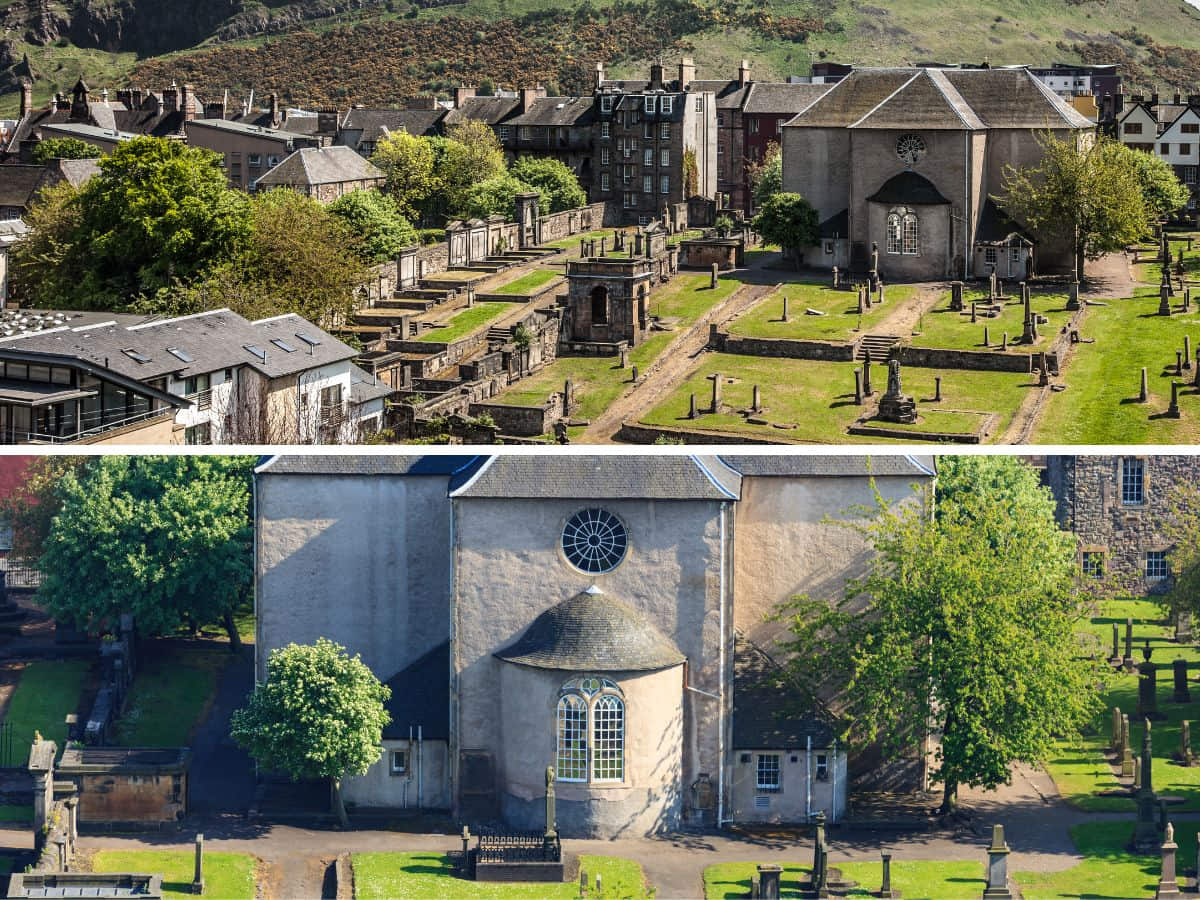
Canongate Kirk, located in the historic Canongate area of Edinburgh, is a prominent Presbyterian church with a history dating back to the late 17th century. King James VII of Scotland ordered the construction of the church, which James Smith designed and finished in 1691.
The unique Dutch-style architecture of the church, featuring a cross-shaped layout (very unusual for a Scottish church of the time), makes it worthy of a visit for any tourist walking up the Royal Mile from Holyrood Palace which is situated just over 1,000 feet away at the bottom end of the historic road.
Throughout its history, Canongate Kirk has been associated with many notable figures and events, and it’s the final resting place of the Scottish economist Adam Smith (commonly known as the ‘Father of Economics’) and the Scottish philosopher Dugald Stewart,who has a memorial on Calton Hill.
The kirkyard is also notable for being a favourite robbing site of the notorious duo Burke and Hare who dug up several graves across Edinburgh in 1828 in order to sell the recently deceased bodies to the city’s medical schools.
In more recent times, the church has had connections to the Royal Family; in 1947, Queen Elizabeth II visited Canongate Kirk during her first visit to Scotland as a monarch, and in July 2011, her granddaughter Zara Phillips married Mike Tindall, a former England rugby captain, at Canongate Kirk.
The church is still an active place of worship, and visitors can attend Sunday services to experience it firsthand, or they can explore it on most days during the summer months when the church is open to the public free of charge.
Inside, visitors can admire a number of unique features, such as the royal pew (designated for use by members of the royal family) and the pipe organ, which was installed in 1998 in memory of Reverend Ronald Selby Wright,who was famous for his wartime radio broadcasts.
The kirkyard is also worth exploring to see the graves that were covered with ironwork to prevent the bodies from being dug up by graverobbers, after which visitors can head to a number of nearby attractions such as Holyrood Park, the Scottish Parliament Building, and Dynamic Earth.
Holyrood Abbey
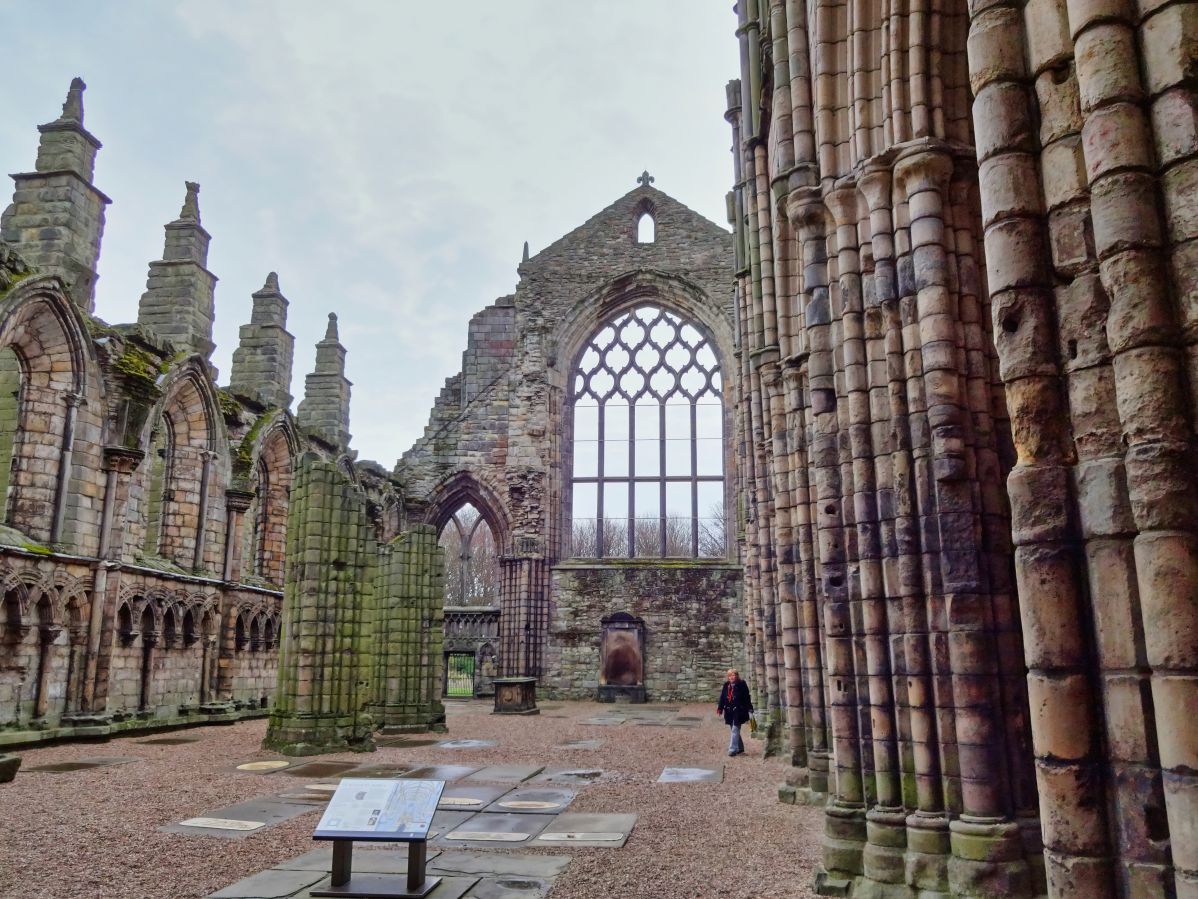
| Address: | Canongate, Edinburgh, EH8 8DX |
| Opening Hours: | 1 November - 31 March: 09:30 to 15:15 1 April - 31 October: 09:30 to 16:30 |
| Admission Price: | Adult: £18.50 Young Adult: (18-24) £12 Child: £10.50 |
| Parking: | Paid car park on Queens Drive |
| Contact: | 0303 123 7306 |
| Facilities: | Gift shop, cafe, toilets, guided tours, disabled access |
| Photos: | YouTube Video |
| BUY TICKETS | Click here to purchase |
Out About Scotland Guide: Holyrood Palace
Holyrood Abbey, founded in 1128 by King David I of Scotland, is a historic ruin located in the heart of Edinburgh, adjacent to the Palace of Holyroodhouse. Entry to the abbey is included with the purchase of a ticket to the palace, so it’s a must-do for tourists, though as it’s completely in ruin and exposed to the weather,it’s perhaps best left for the warmer months.
Throughout its history, Holyrood Abbey has been associated with several prominent figures. Besides King David I who founded the Abbey, other notable figures include Mary, Queen of Scots, who resided in the adjacent palace and used the Abbey for her private chapel, and Bonnie Prince Charlie who held court at Holyrood Palace during the 1745 Jacobite uprising.
However, even royal connections couldn’t save the abbey from the ravages of a mob in 1688, when the royal tombs were desecrated, and following the move of the royal court to London shortly after, it was eventually abandoned.
The final nail in the coffin was the addition of stone roof trusses, which collapsed in 1768, leaving the structure in the roofless condition that we see it in today. Even so, the remaining structure stands as a testament to its former grandeur, and tourists can at least explore the Abbey’s ruins to imagine it in its prime and appreciate its Gothic architecture.
Though it won’t take long to explore Holyrood Abbey, visitors can spend a good 1-2 hours in the palace,either on a guided tour or walking around at their leisure, in addition to viewing the many artworks in the adjoining Queen’s Gallery.
A large part of the palace is open to the general public, including the royal apartments and the Great Gallery, but there are some sections that are off-limits due to the fact that Holyrood Palace is the official Scottish residence of the British monarch and is used for state functions at various times throughout the year.
St. Anthony’s Chapel Ruins
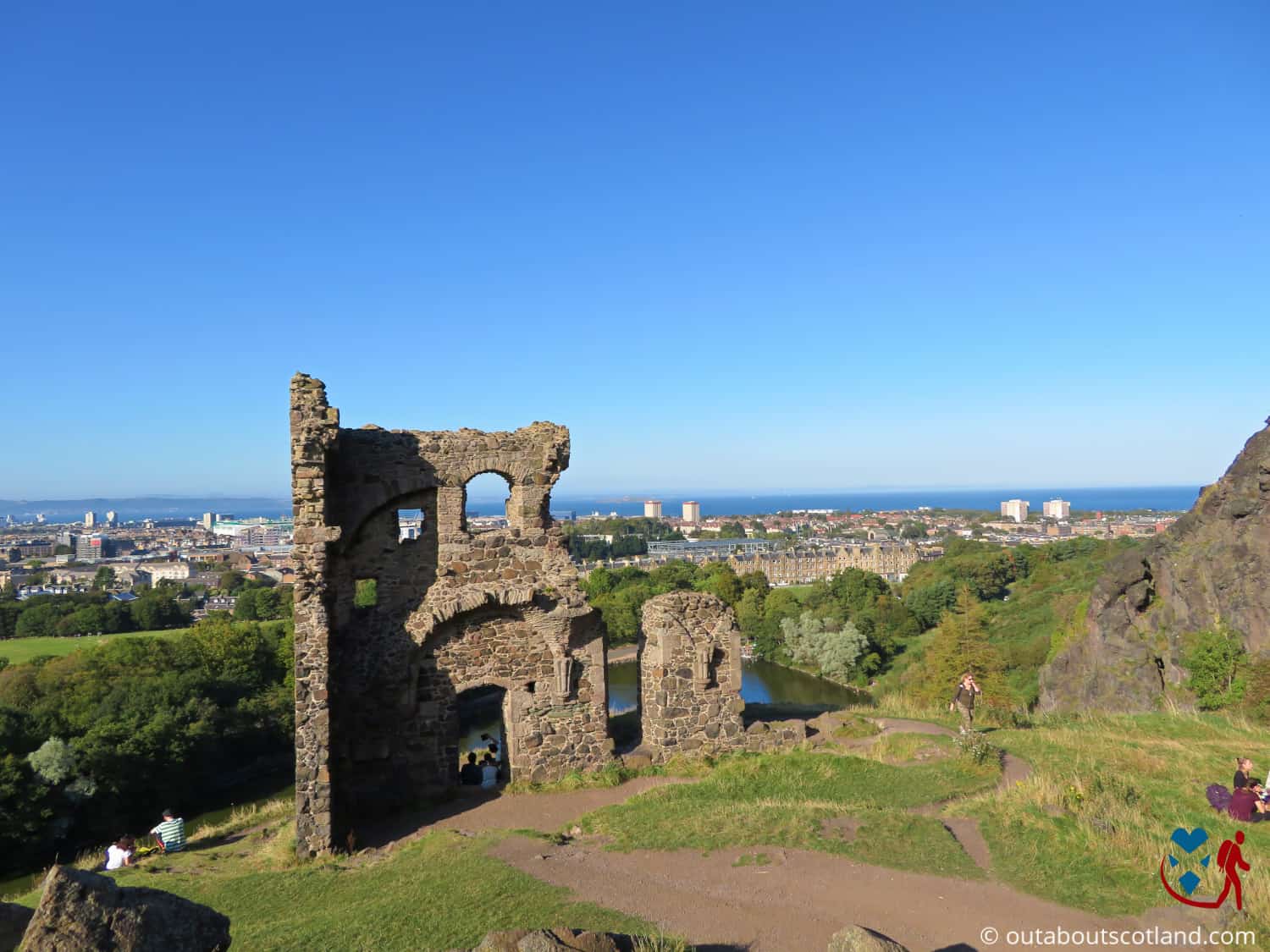
| Address: | Queen's Drive, Edinburgh, EH8 8HG |
| Opening Hours: | Holyrood Park is accessible on foot 24/7, 365 days a year. The park is closed to cars at the weekend. |
| Admission Price: | There is no fee to visit Holyrood Park. |
| Parking: | Parking is available at Broad Pavement, St Margaret's Loch, and Duddingston Loch car parks. Broad Pavement parking is paid (approx £1 per hour) except for Historic Environment Scotland members. The other car parks are free. |
| Contact: | NA |
| Facilities: | There are no facilities within Holyrood Park. There are a multitude of visitor facilities available on the Royal Mile including shops and restaurants. Toilets are available at the Holyrood Park education centre (1 Queen's Drive, Edinburgh, EH8 8HG). |
| Photos: | Virtual Tour YouTube Video |
Out About Scotland Guide: Holyrood Park
St. Anthony’s Chapel Ruins is a fascinating historical site located in Holyrood Park, facing Queen’s Drive and overlooking St. Margaret’s Loch. The remnants of the chapel date back to the 15th century, and although its exact origins are uncertain, it’s believed to have been built to protect a nearby holy well that has now dried up completely.
The holy well was located halfway between St. Anthony’s Chapel and Holyrood Abbey,which is about a quarter of a mile to the northwest. It is likely that friars from the abbey used the chapel for religious services because there was a stone pathway with large kerbstones connecting the two holy sites (remains of which are still visible in some places).
While little is known about the chapel’s early years, it’s depicted in a 1544 sketch of Edinburgh,which shows it intact with a single-story main building and a tall tower at its western end.
It’s also described in Sir Walter Scott’s 1818 novel The Heart of Midlothian as ‘situated in the depth of the valley behind Salisbury Crags, which has for a background the north-western shoulder of the mountain called Arthur’s Seat, on whose descent still remain the ruins of what was once a chapel, or hermitage, dedicated to St. Anthony the Eremite’.
It’s likely that St. Anthony’s Chapel suffered the same fate as most other religious buildings after the 16th-century Reformation when Scotland became primarily Presbyterian, which in turn led to the total abandonment of many Catholic buildings.
Visiting St. Anthony’s Chapel today is well worth the effort involved in climbing the rocky outcrop it’s perched on, as it offers stunning views of the city to the north and the rolling peaks of Holyrood Park to the south, including the iconic Arthur’s Seat.
While exploring the ruins, visitors can admire the remaining walls and soak up the tranquil atmosphere of Holyrood Park in a location that’s perfect for photos before ambling around the rest of the park on a network of paths that spread out in all directions.
Tolbooth Kirk (The Hub)
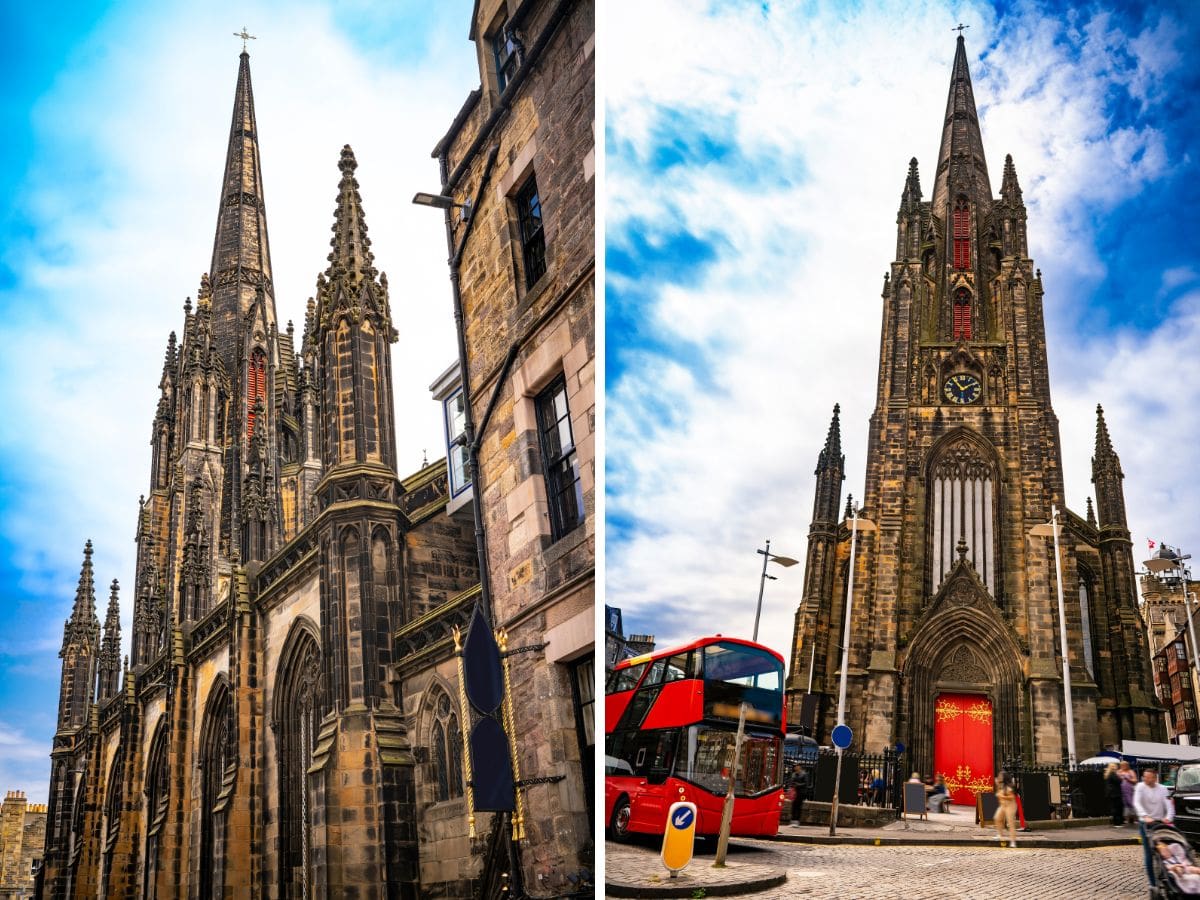
The Tolbooth Kirk is situated in a prominent position on the Royal Mile, not far from Edinburgh Castle and the Grassmarket. The building was designed by renowned architects Augustus Pugin and J.Gillespie Graham between 1842 and 1845 as a meeting hall for the General Assembly of the Church of Scotland, and it’s characterised by its remarkable Gothic-style spire, which dominates the skyline of central Edinburgh.
Throughout its history, the Tolbooth Kirk has played an essential role in the religious, social, and cultural life of the city. It hosted numerous meetings of the Church of Scotland between 1845 and 1929 and was used as a place of worship by various congregations afterwards, although it was never actually consecrated as a church.
In 1956, the Tolbooth Kirk was renamed the Highland Tolbooth St John’s Church and was famous for holding services in both Scottish Gaelic and English, but after the congregation merged with Greyfriars Kirk in 1979, the building was abandoned.
Thankfully, it was saved in 1999 when it was renovated and repurposed as ‘The Hub’, a multi-purpose venue that now serves as the headquarters for the Edinburgh International Festival. This transformation has breathed new life into the building, allowing it to continue its role as a cultural and social city centre venue.
As a tourist, visiting the Tolbooth Kirk offers an opportunity to appreciate its stunning architecture and enjoy performances during the festival,which runs annually in August, while for the rest of the year, it’s a good option for weary sightseers to take a break thanks to the excellent cafe on the ground floor.
Frequently Asked Questions
What is the most popular religion in Scotland?
Christianity is the most popular religion in Scotland. According to the 2011 Census, 53.8% of the Scottish population identified as Christian. The Roman Catholic Church is the second-largest Christian denomination, after the Presbyterian Church of Scotland.
What percentage of Scottish are Catholic?
As of the most recent data available, it is estimated that around 16–17% of the Scottish population identify as Roman Catholic. However, it is essential to note that this percentage may vary each year due to factors such as migration, birth rates, and religious conversions.
What is the national religion of Scotland?
The Church of Scotland, also known as The Kirk, is the country’s largest religious denomination and is recognised in law as the national religion of Scotland. John Knox had a significant impact on the development of the Church of Scotland during the Reformation of 1560, when it broke away from the Catholic Church.
Is the Church of Scotland Catholic?
No, the Church of Scotland is not Catholic. It is a Presbyterian church, which is a branch of Protestant Christianity. The Church of Scotland was established during the Scottish Reformation in the 16th century, when it broke away from the Roman Catholic Church.
The primary difference between the Church of Scotland and the Catholic Church lies in their governance and theological beliefs.

